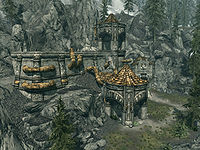
Dwemer ruins are all that remain of the underground cities and strongholds of the Dwemer. They are found everywhere in Tamriel, being a common sight in Morrowind[1][2][3] (especially Vvardenfell), Skyrim[4][3] and Hammerfell,[5][3] with some also present in High Rock.[3][6] Most of these ruins are guarded by functional and self-repairing Dwemer constructs.
Many Dwemer settlements continue to be inhabited even after the disappearance of the Dwarves. They often serve as lairs for outcasts such as bandits and vampires, while some, such as Markarth and Dagon Fel, have been renovated and function as modern settlements. In Skyrim, the twisted Falmer continually reclaim the ancient ruins of their former masters.
The Third Empire established a law that protected Dwemer artifacts salvaged from ruins as property of the Emperor and thus banned from trade. The Empire's goal was to learn the knowledge from the Dwemer's ancient technological treasure troves and use it to improve their own armaments with steam-power and magicka to create inventions such as steam-driven carriages and airborne dirigibles.[7] Despite this, people regularly hunt for these artifacts in Morrowind.[1] The most valuable treasures are Dwarven weapons and armor, both for their craftsmanship and value to collectors and scholars.[8] Some sites can be claimed by the Imperial Archaeological Society per the Dwarven Reclamation Act of 2E 864.[9]
StructureEdit
The structure of Dwemer ruins varies with location, with those located on Vvardenfell being significantly different from those found on the rest of Tamriel. Vvardenfell ruins are typically shallow, with many civic and operational buildings located close to the surface. The ruins on the mainland are usually deeper, with minor warehouses and passageways located near the surface. In these ruins, the actual settlement is hidden deep underground, beneath a certain threshold referred to as the "geocline".[6][10]
Dwemer ruins often contain structures like the Arcanex, where magical objects and text were stored, or the Great Animoculotories, which acted as factories of centurions and other constructs. Some cities, like Bthardamz in Skyrim, were partially built into natural caverns, referred to as the "Deep Venues". The largest of those could even contain underground roads.[11] Dwemer architecture consists mainly of Dwarven metal and stone. It often incorporates subterranean magma in order to power the machinery and intricate mechanisms found within.
Known Dwemer RuinsEdit
- Morrowind
- Skyrim[4][3]
- Hammerfell[3][5]
- High Rock[3]
- Solstheim[16]
- Other
NotesEdit
- The Dwarven Orrery complex at the Arcane University in Cyrodiil is not a Dwemer ruin. Instead, it was built by the Imperials from imported machinery.[20][21]
- The Ancient Tales of the Dwemer series mentions Dwemer locations of Bthalag-Zturamz, Duathand, Lorikh, and Othrobar, but the books are largely considered fiction, meaning it is unknown whether they are real locations (Lorikh in particular is noted to be a Dunmer name).[22]
ReferencesEdit
- ^ a b Dwemer Ruins generic description in Morrowind
- ^ a b Events of Morrowind
- ^ a b c d e f g h i j k Events of ESO
- ^ a b Events of Skyrim
- ^ a b Events of Redguard
- ^ a b Dwemer Inquiries Vol I — Thelwe Ghelein, Scholar
- ^ Lakene's dialogue in Redguard
- ^ Dwemer Artifacts generic description in Morrowind
- ^ No Trespassing
- ^ Dwemer Inquiries Vol III — Thelwe Ghelein, Scholar
- ^ Dwemer Inquiries Vol II — Thelwe Ghelein, Scholar
- ^ Events of Morrowind: Tribunal
- ^ a b Ruins of Kemel-Ze — Rolard Nordssen
- ^ a b c Chronicles of Nchuleft — An Anonymous Altmer
- ^ Notes For Redguard History — Destri Melarg
- ^ Events of Skyrim: Dragonborn
- ^ Nchunak's Fire and Faith — Nchunak
- ^ Katria's Journal — Katria
- ^ Valinka Stoneheaver's correspondence in ESO
- ^ Note from Bothiel — Bothiel
- ^ Original obliviondownloads.com Orrery description
- ^ Ancient Tales of the Dwemer — Marobar Sul